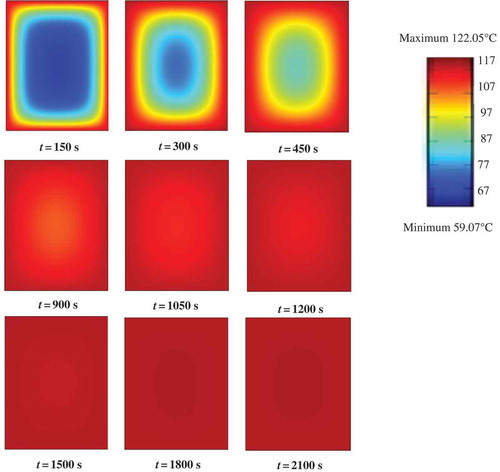Abstract
Sterilization process of canned pickled escamoles and canned brined escamoles was studied in order to analyze the heat transfer mechanisms as well as to calculate the thermal properties and process time. Sterilization process was performed using water immersion and saturated steam at 115°C and 121°C. Transient temperature changes in the cold point inside of the can containing either pickled or brined escamoles were determined experimentally and compared with simulation results. Additionally, the physicochemical, nutritional and sensory quality properties of sterilized escamoles were also evaluated. Uniform and conductive heating profiles were observed in both products. The thermal conductivity (k), specific heat (Cp) and density (ρ) were significantly affected (p < 0.05) by the temperature and by the heating medium. Results also showed that maximum quality retention and the lowest process times were achieved for canned pickled escamoles.
El proceso de esterilización para el enlatado de escamoles en escabeche y en salmuera fue estudiado para analizar los mecanismos de transferencia de calor y para calcular las propiedades térmicas y el tiempo de proceso. El proceso de esterilización se realizó usando inmersión en agua y vapor saturado a 115°C y 121°C. Los cambios de temperatura en el punto frío dentro de la lata la cual contenía escamoles en escabeche o escamoles en salmuera fueron determinados experimentalmente y por simulación. Las propiedades fisicoquímicas, nutricionales y sensoriales de los productos terminados también fueron evaluadas. Transferencia de calor por conducción fue observada en ambos productos. La conductividad térmica (k), el calor específico (Cp), y la densidad (ρ) fueron afectados significativamente (p < 0,05) por la temperatura y por el medio de calentamiento. Los resultados también mostraron que los productos con mayor calidad y menor tiempo de proceso fueron los escamoles en escabeche.
Introduction
The consumption of insects as food or “entomophagy” has significantly increased worldwide, either for pleasure or to satisfy the food needs in developing countries. Insects can be considered as an important source of protein and other nutrients such as fat, vitamins and minerals (Ramos-Elorduy, Pino-Moreno, & Conconi, Citation2006). Especially in developed countries such as Angola, Brazil, Colombia, China, Ecuador, Peru, Thailand, Zaire, Mexico, Nigeria, Republic of Congo and Zambia, humans have selected around 2000 species of edible insects. For instance, several species of grasshoppers (Sphenarium histrio mexicanum), maguey worms (Comadia redtembacheri) and escamoles (Liometopum apiculatum) are part of the diet of some ethnic groups in Mexico (Ramos-Elorduy, Costa, Pino-Moreno, Cuevas, & García, Citation2007). Escamoles are the larvae of ants of the genus Liometopum, consisting of a mixture of immature states known as pupa, with an average length of 7–10 mm, 3–5 mm in diameter and a yellow-pearl color as shown in (color online only). They are known as “Mexican caviar” because of its delicious taste and high cost. The most important escamoles production zones in Mexico are located in the states of Mexico, Hidalgo, Tlaxcala, Zacatecas and San Luis Potosi, all of them with short collection periods from February to April. Escamoles have a chemistry composition consisting of approximately 73% water, 10% protein, 10% carbohydrates and 6% lipid (Ramirez-Garcia, Ruiz-Cabrera, & Grajales-Lagunes, Citation2013). Nevertheless, due to its high proteolytic enzymes content, escamoles have a very poor shelf life, and only a very small proportion of the yearly harvest reaches the national market, mainly due to the lack of a good method of preservation that facilitates transportation and storage. Escamoles cannot be stored for more than 8 days at 4°C because decay will take place after that span. On the other hand, a puncture of the walls and loss of its natural juices during thawing has been observed in frozen escamoles (results not published). Canning and thermal sterilization as preservation methods may be an alternative for a better utilization of escamoles and could be suitable for creating new variety of products at a large scale. Thermal sterilization process has been widely used as a method of preservation for some products such as tuna fish, vegetables and pates (Garrote, Silva, Roa, & Bertone, Citation2006; Kızıltas, Erdogdu, & Palazoglu, Citation2010; Plazl, Lakner, & Koloini, Citation2006) because the high heat destroys microorganisms and inactivates enzymes to preserve the safety and quality of the food. The heat transfer during thermal processing of a food has been directly related to the type of food and sterilization method. Therefore, heat transfer analysis has been recommended in literature to improve its design and operation as well as to save energy in canned products (Desrosier, Citation2006). For instance, Chen and Ramasswamy (Citation2007) pointed out that heat transfer modes in a canned food is conduction for solid foods, natural convection for low-viscosity liquid foods, convection plus conduction for liquid foods with solid particles and convection followed by conduction for liquid foods containing starch or high-viscosity modifiers. However, in the literature, no information is available regarding the analysis of heat transfer, thermal properties and determination of required processing time for canned escamoles. Therefore, the aim of this study was to characterize the sterilization process through temperature measurements in the cold point of the can in order to estimate and elucidate the thermal properties, heat transfer mechanisms and processing time for canned escamoles. Additionally, the physicochemical, nutritional and sensorial characteristics were evaluated in the product after sterilization process.
Materials and methods
Sample preparation and sterilization tests
Escamoles were collected at Ejido de Pocitos, at the Municipality of Charcas San Luis Potosi, México and immediately they were carefully washed with sodium hypochlorite at 150 ppm and were frozen at −80°C until its use. Pickled and brined escamoles were prepared according to the Official Mexican Norm (NOM-002-SCFI, Citation1993) as shown in . Cylindrical cans of 250 mL volume with a diameter of 66 mm and height of 75 mm were used in all experiments. The filling of the cans were performed at 80°C considering a headspace of 10 mm as indicated in and hermetically sealed using a sealing machine (DIXIE Double Seamer model 25D-600, Athens, GA, USA). The thermal exhausting was carried out with saturated steam at 80°C. Sterilization process was performed using saturated steam and water immersion at 115°C and 121°C, both in a stationary vertical autoclave. Saturated steam at pressures of 1.1 and 1.5 kg/cm2 and boiling water with over-pressure of 2.2 kg/cm2 with compressed air were used, respectively, as heating mediums. A factorial experimental design completely randomized with three factors at two levels each and one replicate for each experimental condition was used. A total of 16 runs were conducted ().
Table 1. Formulation of brined and pickled escamoles.
Tabla 1. Formulación de los escamoles en salmuera y escabeche.
Figure 2. Experimental setup and illustration of the location of thermocouple to measure cold point temperature in the geometric center (r = 0) at three different heights along the axis of the cans.
Ilustración experimental de la ubicación de los termopares para determinar la temperatura del punto frio en el centro geométrico (r = 0) a tres diferentes alturas a lo largo del eje de la lata.
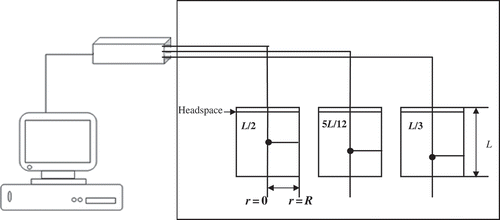
Table 2. Experimental sterilization conditions for canned escamoles.
Tabla 2. Condiciones experimentales del proceso de esterilización para el enlatado de escamoles.
Cold point measurement
The cold point temperature inside the cans filled with escamoles products was determined by placing T-type thermocouples in the geometric center (at r = 0) at three different heights along the axis (L/2, 5L/12, L/3) of the cans as shown in . The temperature as a function of sterilization time was recorded with a data acquisition system (CALplex) with an accuracy of ±0.5°C and read by a personal computer through the data acquisition program.
Calculation and validation of the process time
The process time was calculated using Equation (1)
Chemical composition, physicochemical parameters and sensory evaluation of the final product
Chemical composition of final product was determined by the method of Association of Official Analytical Chemists (AOAC, Citation1990). The pH of drained product was determined with a glass electrode attached to a Thermo-Orion pH-meter (model 410Aplus) and water activity (Aw) with water activity meter (Aqualab Series 3 TE), both at room temperature. The sensory evaluation was performed with 52 untrained judges using a 7-point hedonic scale: 1 = “dislike very much”, in the middle “neither like nor dislike” and 7 = “like very much”.
Heat transfer simulation
The simulations were performed by computational fluid dynamics using the software Comsol Multiphysics version 3.5. During heat transfer simulation, the headspace was not considered due to the small variability in the effective heat transfer coefficients for headspace between 5 and 10 mm (Ibrahim, Citation2007). In addition, it was also assumed that pickled escamoles and brined escamoles were completely homogeneous; then an analysis of transient energy transport by conduction was performed. Two-dimensional geometries in cylindrical coordinates, considering only the radial and axial directions when the angle θ is equal to zero (), were used. The boundary conditions were considered as convective energy flow. Thermophysical properties of food such as thermal conductivity (k), specific heat (Cp), density (ρ) and the heat transfer convection coefficient (h) were determined as described in the following and supplied to the software. The governing equation for heat transfer inside the cans can be written as
Figure 3. Tri-dimensional schematic representation of the vertical can used in this study.
Representación esquemática tridimensional de la lata en posición vertical usada en este estudio.
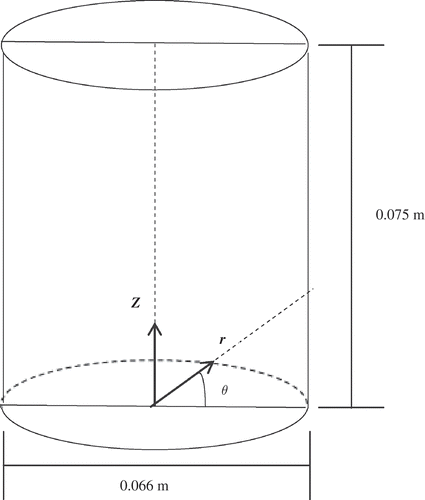
Thermophysical properties determination
In this study, two different procedures were used for estimation of thermophysical properties. In a first attempt, the resistance of convective heat transfer was considered negligible fixing a high value of h = 1 × 1010 W/m2/°C while k, Cp and ρ were assumed to be a function of temperature and product composition; then, the Equations (7)–(10) proposed by Choi and Okos (Citation1986) were used:
Statistical analysis
A linear model with binary interactions (Equation (12)) was used to analyze the effect of the canned product (A), heating medium (B) and sterilization temperature (T) on each of the response variables (k, h, Cp, ρ, Aw, pH and process time):
Results and discussions
Evolution of experimental and simulated temperature
It was noticed that the cold point temperature for sterilized brined escamoles using water immersion was located at L/2, whereas for brined escamoles treated with saturated steam, this was located between L/2 and L/3. However, for sterilized pickled escamoles using either water immersion or saturated steam, the cold point was located at L/2. Based on the fact that temperature evolution was similar for all experiments, as an example, ()–() and ()–() shows the experimental and simulated cold point temperature evolution when brined and pickled escamoles were heated with water immersion and saturated steam at 121°C, respectively. In ()–(), it is seen that both simulation procedures, Choi and Okos and nlr, satisfactorily predicted the variation of the cold point temperature for brined escamoles. However, the predicted values using the nlr procedure are in better agreement with experimental values than those predicted using the Choi and Okos equations when pickled escamoles were used (()–()). An ideal mixture assumes that volumetric and energetic properties of a mixture are just the linear combination of those of their pure constituents. Probably, the discrepancy observed between simulated and experimental data in pickled escamoles using Choi and Okos equation may be attributed to deviation from the simple ideal mixture model. Based on the latter assumption, brined escamoles can be considered as a thermodynamically ideal mixture under any conditions that were used in this study. As an example, simulated temperature contours for the case of brined escamoles treated with saturated steam at 121°C is given in at different heating times. From , it is evident that the product adjacent to the walls of the can receive a rapid heating, while the center where the temperature change was measured was the slowest heating point in the can. On the other hand, it may be inferred from that the heat transfer was mainly by conduction with uniform kernels of temperature zone. It is also important to indicate that similar trends were perceived in the experiments performed with pickled escamoles.
Figure 4. Comparison between experimentally measured and simulated cold point temperatures for sterilization carried out at 121°C. (a) Exp. 6, (b) Exp. 8, (c) Exp. 5, (d) Exp. 7 from , nlr = nonlinear regression.
Comparación entre los resultados experimentales y simulados de la temperatura en el punto frio durante la esterilización realizada a 121°C, (a) Exp 6, (b) Exp 8, (c) Exp 5, (d) Exp 7 de la , nlr = regresión no lineal.
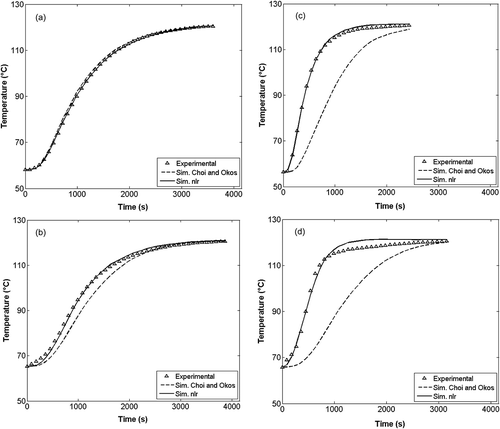
Thermophysical properties
The thermophysical properties values estimated by Choi and Okos and by nlr for each experimental condition are given in . According to ANOVA (p < 0.05) shown in , it can be observed that thermal conductivity (k), specific heat (Cp) and density (ρ) were influenced by the studied factors. With respect to heat transfer convection coefficient, significant effect of the sterilization variables was not observed. An increase of h with temperature, headspace and rotary speed has been reported in the literature when a rotary retort was used (Garrote et al., Citation2006). However, in this study, a stationary autoclave was used for the sterilization processes. From , it can be noticed that k and Cp values were directly proportional to the sterilization temperature, whereas the opposite effect was found for ρ, which decreased with sterilization temperature. On the other hand, similar values of thermal conductivity (k) were estimated using Choi and Okos equation and nlr procedure in brined escamoles but different k values in pickled escamoles (p < 0.05) (). As previously discussed, Choi and Okos equation is more suitable to predict the thermophysical properties of ideal mixture model such as brined escamoles. In the literature, some authors have reported values for the thermal properties of various canned foods (Boz & Erdogdu, Citation2013; Kannan & Gourisankar, Citation2008), and some of them are similar to those reported in this study.
Table 3. Thermophysical and physicochemical properties and process time for canned escamoles products.
Tabla 3. Propiedades termo-físicas y fisicoquímicas y tiempo de proceso para los productos de escamoles enlatados.
Table 4. Regression coefficients of the quadratic model (Equation (12)) to evaluate the effect of the product type, type of sterilization and temperature on k values, h, Cp, ρ, Aw, pH and process time.
Tabla 4. Coeficientes de regresión del modelo cuadrático (Equation (12)) para evaluar el efecto del tipo de producto, tipo de esterilización y la temperatura sobre los valores de k, h, Cp, ρ, Aw, pH y tiempo de proceso.
Experimental and calculated process time
The process time is an important parameter that must be carefully determined for foods requiring a canning and sterilization process because it depends on the type of food and experimental conditions. This parameter is widely used to ensure the absence of pathogens in food, which can cause an effect on the human health. Therefore, process time must be also validated through microbiological tests such as that used in this study, which were negative for all experiments. The experimental and predicted process time for each experimental condition investigated are also given in . According to ANOVA (p = 0.0001, r2 = 0.998), the process time was affected by the product type (pickled or brined escamoles), by the temperature and by the product type × heating medium and product type × temperature interactions (). Pickled escamoles required less process time than brined escamoles regardless of the heating medium suggesting that there is greater heat transfer in pickled escamoles. Processing times estimated by nlr were closer to the experimental processing times than those estimated by Choi and Okos due to the lack of fit of the experimental data observed during the simulation.
Chemical composition and physicochemical properties of processed escamoles
Fresh escamoles constitute a good source of protein (10.15% wet basis), carbohydrates (10%) and lipids (6%). Data on the protein content in processed escamoles showed that this compound was sensitive to heat, and the remaining percentage of protein varied from 4.2% to 6.0%. It was observed that the remaining percentage of protein was higher in brined escamoles than pickled escamoles. This protein degradation can be attributed to protein denaturalization during thermal sterilization as well as to hydrolysis of proteins induced by the pH value. Even taking into account the maximum loss of protein observed in pickled escamoles, the remaining is high compared to other Mexican pickles products such as pickled mushroom whose protein content is around 1.1% (wet basis). With respect to physicochemical parameters of products, shows the average results of water activity (Aw) and pH for each experiment. Aw values ranged between 0.98 and 0.99, which were very similar to the water activity (0.98 ± 0.05) for fresh escamoles, suggesting that the factors evaluated (product type, heating medium, temperature and their respective interactions) caused no significant effect (p = 0.548, r2 = 0.37) on the Aw value. According to ANOVA, the pH was affected only by the product type (p = 0.0001, r2 = 0.98) (). A decrease of pH was observed in the sterilized products () due to the fact that the pH value of fresh escamoles varies between 6.5 and 6.7, the lowest pH value was 4.21 ± 0.03 (pickled escamoles heated with steam at 115°C) and the highest value was 6.29 ± 0.06 (brined escamoles heated with water immersion at 115°C). pH values decreased more drastically in the pickled escamoles because acetic acid (vinegar) was used in its formulation. Therefore, pickled escamoles may be classified as high-acidity products and brined escamoles as low-acidity products.
Sensory quality in finished product
shows the results of overall quality (taste, color, texture and appearance) for finished products. The product with highest score was pickled escamoles heated with steam at 115°C (A) where the average score was approximately of 6.0, according to the hedonic scale, it means “like moderately”. This score can be considered satisfactory because these products are new and exotic and some judges have never tasted them. The other escamoles products such as pickled-immersion at 115°C (B), pickled-immersion at 121°C (C), pickled-steam at 121°C (D), brined-immersion at 121°C (G) and brined-steam at 121°C (H) obtained an score of 5.0, which is equivalent to “like slightly” these products were statistically different (p < 0.05) to product A. The score for brined-steam at 115°C (E) and brined-immersion at 115°C (F) was of 4.0, which was equivalent to “neither like nor dislike”. These results suggest that the overall quality of these products was satisfactory because all samples received a positive score. The final comment from the judges was that all products had a good taste and a very good appearance.
Figure 6. Overall quality scores for sterilized escamoles products. A: pickled-steam at 115°C, B: pickled-immersion at 115°C, C: pickled-immersion at 121°C, D: pickled-steam at 121°C, E: brine-steam at 115°C, F: brine-immersion at 115°C, G: brine-immersion at 121°C, H: brine-steam at 121°C.
Calidad sensorial para los productos de escamoles esterilizados A: escabeche-vapor a 115°C, B: escabeche-inmersión a 115°C, C: escabeche-inmersión a 121°C, D: escabeche-vapor a 121°C, E: salmuera-vapor a 115°C, F: salmuera-inmersión a 115°C, G: salmuera-inmersión a 121°C, H: salmuera-vapor a 121°C.
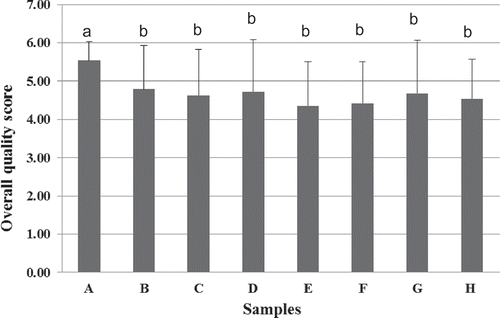
Conclusions
Sterilization process can be used to give added value to escamoles without damaging its nutritional and sensory characteristics. Conduction was the main heat transfer mechanism during the sterilization process in pickled and brined escamoles; however, pickled products required less process time than brine products. Sterilization process conditions and thermal properties of canned escamoles determined in this study can be used to generate new products based on escamoles in different geometries and sizes of the can without the need for further experiments. Good agreement between the experimental and simulated temperature profiles was observed using either the nlr or Choi and Okos procedures in brined escamoles. Therefore, Choi and Okos equation was more suitable to predict the thermophysical properties of ideal mixture model.
References
- Association of Official Analytical Chemists (AOAC). (1990). Official methods of analysis (13th ed.). Washington, DC: Association of Official Analytical Chemists.
- Boz, Z., & Erdogdu, F. (2013). Evaluation of two-dimensional approach for computational modelling of heat and momentum transfer in liquid containing horizontal cans and experimental validation. Food and Bioproducts Processing, 91, 37–45. doi:10.1016/j.fbp.2012.08.005
- Chen, C. R., & Ramaswamy, H. S. (2007). Visual basics computer simulation package for thermal process calculations. Chemical Engineering and Processing: Process Intensification, 46, 603–613. doi:10.1016/j.cep.2006.08.003
- Choi, Y., & Okos, M. F. (1986). Effects of temperature and composition on the thermal properties of foods. In M. LeMaguer & P. Jelen (Eds.), Food engineering and process applications (pp. 102–106). London: Elsevier Applied Science.
- Desrosier, N. W. (2006). Conservación de alimentos. México: CECSA.
- Garrote, R., Silva, E. R., Roa, R. D., & Bertone, R. A. (2006). Heat transfer coefficients to canned green peas during end-over-end sterilisation. International Journal of Food Science and Technology, 41, 1016–1022. doi:10.1111/j.1365-2621.2006.01158.x
- Ibrahim, O. M. (2007). Determination of an effective heat transfer coefficients for can headspace during thermal sterilization process. Journal of Food Engineering, 79, 1166–1171. doi:10.1016/j.jfoodeng.2006.04.015
- Kannan, A., & Gourisankar, S. (2008). Heat transfer analysis of canned food sterilization in a still retort. Journal of Food Engineering, 88, 213–228. doi:10.1016/j.jfoodeng.2008.02.007
- Kızıltas, S., Erdogdu, F., & Palazoglu, T. K. (2010). Simulation of heat transfer for solid–liquid food mixtures in cans and model validation under pasteurization conditions. Journal of Food Engineering, 97, 449–456. doi:10.1016/j.jfoodeng.2009.10.042
- Montgomery, D. C. (2004). Diseño y análisis de experimentos. México: Limusa Wiley.
- NOM-002-SCFI. (1993). Productos preenvasados-contenido neto tolerancias y métodos de verificación. México: Norma Oficial Mexicana.
- NOM-130-SSA1. (1995). Productos pre-envasados contenido neto tolerancias y métodos de verificación. México: Norma Oficial Mexicana.
- Plazl, I., Lakner, M., & Koloini, T. (2006). Modeling of temperature distributions in canned tomato based dip during industrial pasteurization. Journal of Food Engineering, 75, 400–406. doi:10.1016/j.jfoodeng.2005.04.057
- Ramaswamy, H., & Marcotte, M. (2006). Food processing-principles and applications. Boca Raton, FL: CRC Press, Taylor and Francis.
- Ramirez-Garcia, G., Ruiz-Cabrera, M. A., & Grajales-Lagunes, A. (2013). Uso del método de barreras para la conservación de escamoles (Liometopum apiculatum). Mazatlán: Memorias en extenso, Congreso de la Sociedad Mexicana de Ingeniería Química.
- Ramos-Elorduy, J., Costa, N., Pino-Moreno, J., Cuevas, C., & García, F. (2007). Conocimiento de la entomofauna útil en el poblado La Purísima Palmar de Bravo, Estado de Puebla, México. Biotemas, 20, 121–134.
- Ramos-Elorduy, J., Pino-Moreno, J., & Conconi, M. (2006). Ausencia de una reglamentación y normalización de la explotación y comercialización de insectos comestibles en México. Folia Entomológica Mexicana, 45, 291–318.
- Simpson, R., Abakarov, A., Almonacid, S., & Teixeira, A. (2008). Impact of overall and particle surface heat transfer coefficients on thermal process optimization in rotary retorts. Journal of Food Science, 73, E383–E388. doi:10.1111/j.1750-3841.2008.00928.x
| Nomenclature | ||
| Aw | = | water activity |
| ρ | = | density (kg/m3) |
| Cp | = | specific heat (kJ/kg/°C) |
| F0 | = | Lethality sterilization value (min) at 115°C or 121°C |
| h | = | heat transfer convective coefficient (W/m2/°C) |
| k | = | thermal conductivity (W/m/°C) |
| L | = | height of the can (mm) |
| R | = | radius of the can (mm) |
| r | = | radial dimension |
| nlr | = | nonlinear regression |
| SSE | = | sum of squared error |
| T | = | Experimental temperature in cold point (°C) |
| Tref | = | reference temperature (115°C or 121°C) |
| Tsimulated | = | simulated temperature (°C) |
| Xm | = | mass fraction |
| Xv | = | volume fraction |
| z | = | temperature sensitivity for Clostridium botulinium (°C) |


